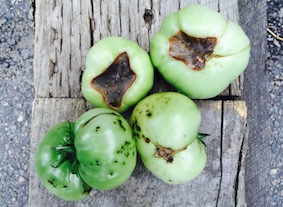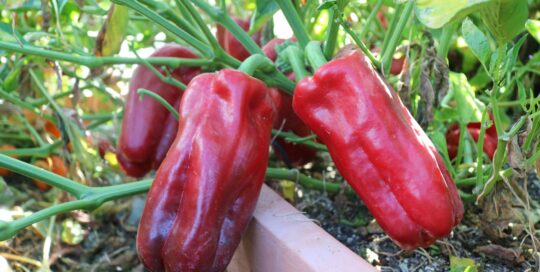Blossom End Rot on Tomatoes
Views: 6367

The springtime garden is lush and full of green, budding things. But July is a different story. This time of the vegetable gardening season is when things can begin to get a little ugly. The little imperfections in leaves or the fruiting flesh—the things we knowingly and dangerously pushed to the corners of our mind—this is the time they come into their own as some sort of disease of deficiency, like blossom end rot.
Take the photo above, for example. There are at least two issues going on. The large, spreading leathery patch (for lack of a better word) is blossom end rot. It’s not a disease, but rather a physiological issue having to do with a lack of calcium. It commonly pops up when the growing season begins cool and wet and turns dry as the fruit begins to set. The spot eventually will begin to rot and decay, so pick the fruit and discard it, as there is no saving a fruit that already has blossom end rot.
What causes blossom end rot?
There are several reasons, and which one is specific to your own issue only you or the plant will know:
– The soil moisture could be fluctuating
– The roots may have been damaged—maybe you hoed too close to the plant?
– The soil may have too much nitrogen
– Soil pH might be off balance;
– The soil could be too cold, especially at planting.
Prevention
Easiest answer: don’t have any of the above reasons happen. Putting that in practice, though, takes a lot more attention.
– Keep an eye on soil moisture. There’s nothing you can do about too much rain, but you can be proactive and water deeply when conditions are dry. I hold my hose at the base of each tomato plant for at least 30 seconds—either 30 straight seconds or for 15 seconds twice (this helps the soil better absorb the water).
– Use mulch to slow evaporation from the soil around your tomatoes.
– Check your soil pH levels. It’s not as complicated as you think. Ask the folks at your local garden center.
– Use a fertilizer lower in nitrogen and higher in phosphorus.
– Use an amendment that has added calcium. There’s a product called Tomato Rot Stop, for one, that is specifically formulated to stop blossom end rot with calcium.
– Make sure your soil is warm before planting. My neighbor puts down black landscape fabric for a few weeks before planting to help warm the soil, then plants right through the fabric.
You’ll also notice two of the tomatoes in that photo have something other than blossom end rot. More on what that is next week.
Meet Ellen Wells
When you’re raised on a farm, you can’t help but know a thing or two about gardening. Ellen Wells is our expert on edible gardening.…
Ellen's Recent Posts

Pepper Red Impact an All-America Selections Winner






